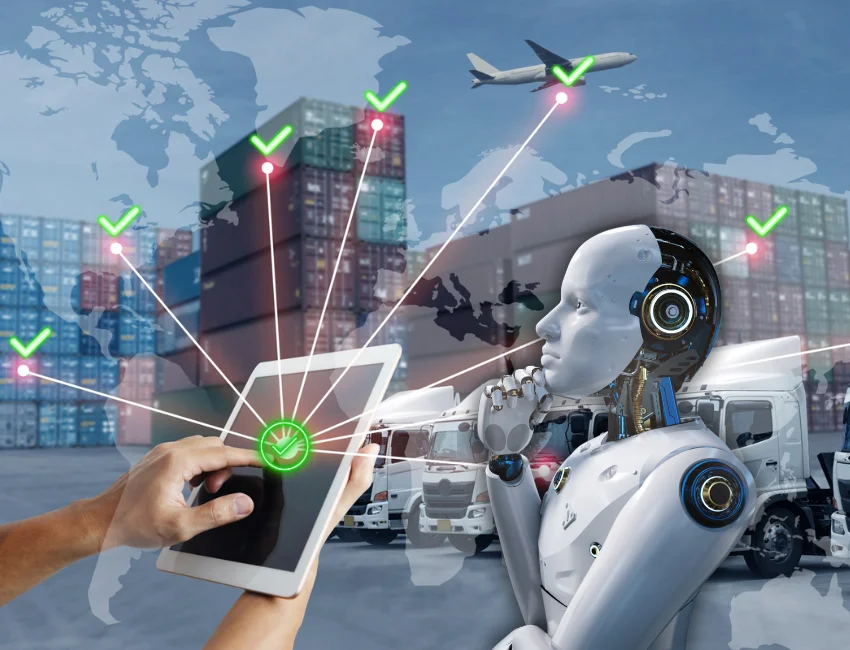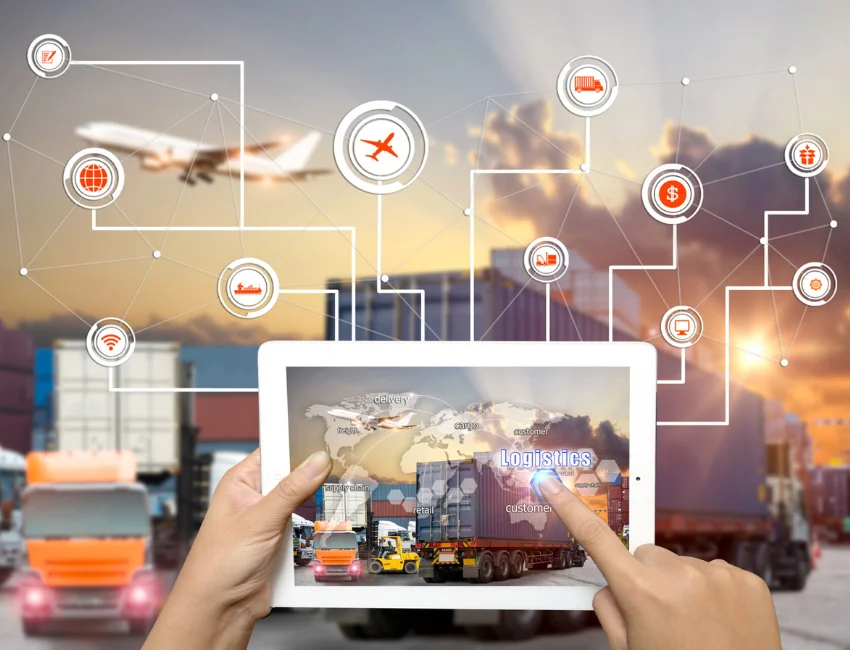

The domain of logistics and supply chain management revolves around timing, planning, and maximizing productivity. However, with the introduction of AI in logistics, these objectives are achieved easily. AI is now a necessity for modern companies. To remain competitive in an advanced global economy, the incorporation of Artificial Intelligence systems is essential.
The application of AI in logistics and supply chain processes is transforming everything from route optimization to warehouse automation. It no longer is simply a matter of saving money; today, that goal encompasses making better, faster decisions, automating human functions, and achieving more across the entire logistics pipeline.
Through this blog, we will focus on the effects of AI on logistics and supply chains across the world. We’ll highlight actionable strategies on how your business can leverage this smart revolution.
Lack of sophisticated planning tools paired with insufficient analysis of past changes forces the majority of the logistics industry to over-rely on human intuition, out-of-date software, and manual adjustments. Such practices fall short of delivering effective solutions for dealing with the more chaotic modern world’s challenges like weather-related delays, demand escalations, or supplier holdups.
In this context, AI logistics software can greatly assist. Unlike traditional tools, AI applications perform information processing at a higher level; they foresee, modify, and optimize workflows instantaneously. AI drives business value by recommending quicker delivery routes or forecasting demand using historical data. With these systems in place, logistics firms gain the competitive advantage they need to operate in volatile conditions.
Businesses are increasingly struggling to meet customer demands with the growing complexity of global supply chains. This is why augmenting traditional AI for logistics is an intelligent move.

Let’s break down some of the best benefits of using AI in enhancing supply chain and logistics operations:
AI algorithms determine the best, fastest, and most fuel-efficient delivery routes by considering traffic patterns, active drivers, delivery deadlines, and current road conditions. This enables companies to complete deliveries on time, every time, which decreases fuel consumption, drastically reduces emissions, and saves on operating costs.
AI systems can predict by can study previous sales patterns, seasonal trends, and other external factors to predict future sales using machine learning. This allows businesses to better manage inventory and avoid the high costs of being overstocked or understocked.
Robotic inventory management systems powered by AI can sort packages, pick items and stack shelves – a feat which reduces human error and enhances accuracy. AI-powered vision systems allow real time monitoring of stock levels within the warehouse.
AI tools offer live updates throughout the whole supply chain from the factory to the final stop. Businesses can reduce bottlenecks and enhance communication with customers while accurately diagnosing issues earlier with enhanced visibility.
AI systems in procurement and supply chain management automatically recommend when to initiate or replenish stock, in what quantities, and which supplier to source it from based on their pricing, lead time, and quality. This optimizes vendor relationships and minimizes waste.
As illustrated by the case examples below, the true value of AI in logistics is found in its creativity. These use cases demonstrate how AI is enhancing modern logistics:
Using Amazon and UPS’s AI logistics software, delivery schedules are constantly and automatically updated to reflect real-time updates, along with other external factors. If a customer address changes or there is congestion on the route, the system dynamically recalculates the best route in real time.
AI sensors embedded in the vehicle monitor performance metrics like engine performance, overall fuel consumption, tyre wear, and even fuel consumption. This allows companies to perform maintenance only when it is absolutely necessary, minimizing breakdowns and improving vehicle lifespan.
Shipment and delivery tracking, as well as return requests, are now autonomously performed by AI bots without any human agents. This significantly lessens waiting times for customers and improves service level across the board. That’s customer service at its best!
AI systems are able to detect fake addresses, suspicious orders, and even duplicate payments because of the anomaly-detection algorithms. This enables companies to avoid financial losses and enhances their belief in online logistics platforms.

There are a few companies that stand out in the industry when we talk about innovations in logistic AI technology, and using various AI logistics software.
FedEx applies AI in automating processes such as package uploading and downloading, vehicle navigation, and real-time surveillance of the consignment. Their SenseAware platform monitors location, temperature, and security status for sensitive packages of clients in real-time.
In the entire network of DHL, AI and Robotics are heavily integrated. DHL smart warehouses operate AI-robots that carry out sorting and inventory checking. The machine learning models increase the effectiveness and eco-friendliness of package delivery time optimization.
Their logistics network is among the most sophisticated in the world. Amazon employs AI at every stage of logistics and supply chains, from product suggestions to robotic picking systems. Their AI forecasting tools enable proper inventory levels to be maintained in different regional warehouses.
This American leader in AI logistics has built proprietary machine learning applications for transport network and warehouse automation management. Their AI-driven platform autonomously reschedules pick-ups or re-routes cargo when shipment delays are predicted.
Larger corporations are not the only beneficiaries of AI logistics software; even small and medium-sized enterprises (SMEs) can take advantage of AI tools to:
As with any technological advancement, businesses should consider the problems that arise with the use of AI in logistics. First, the quality of data for AI integration is vital, as the data should be accurate, complete, and well-organized. Any deviation from these expectations would lead to AI systems making suboptimal decisions.
Many geriatric logistics firms still use outdated software systems that could pose challenges with integration. This brings us to the issue of underinvestment, which although can yield substantial payoffs in the future, setup expenses, employee training, and new software licenses can present significant challenges.
Finally, the appropriate skill gap presents an unaddressed problem. The implementation of AI is simple when armed with the right skill set, such as data science, software engineering, and logistics operations, but these fields do not always provide an easy answer.
The USA is home to some of the most promising AI logistics startups that are changing the way supply chains operate. FourKites, Shipwell, and Convoy are some of the firms utilizing AI to:
These companies are setting the benchmark of what’s possible with AI and logistics, spearheading the use of Silicon Valley technologies in traditional industries.
The rapid increase in technology is making AI supply chain logistics more advanced. Here are some predictions for the next few years:
AI is already a logistical powerhouse, and WebOsmotic special AI services arms you with the tools and strategies to spearhead the transition.
The use of AI in supply chains and logistics is likely one of the key reasons why the industry as a whole is predicted to be worth over 10 trillion USD by 2030, all while contributing to one of the fastest transforming economies in the world. AI computers embedded today are predicting demand, automating delivery, and making operations cheaper and more sophisticated every single day.
Today’s early adopters of these technologies and tools will be tomorrow’s industry leaders. Partnering predictive algorithms with logistics resulted in IoT driven smart warehouses and predictive deliveries. This promises a future of automated fulfillment centers that offer high efficiency with unmatched customer satisfaction and experience.
Whether it is smarter warehouses or predictive deliveries, AI and logistics go hand-in-hand at WebOsmotic because we are committed to sculpting the future. WebOsmotic is here to help you build that future today.